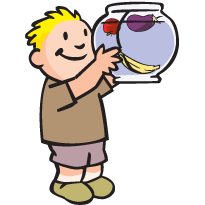Boston Children's Museum
308 Congress Street, Boston, MA 02210
617-426-6500
© Boston Children’s Museum 2025
Website Design by JackrabbitLearning how to make thoughtful predictions and to test those predictions are skills children will need as they learn more and more complex science content. This simple experiment gives them that opportunity while also introducing principles of buoyancy.
Purchase a variety of fruits and vegetables—try to have a mix of sizes and shapes. Fill the bin or tub with water. If you have a cart or dolly or something that rolls, it will make it much easier to transport the heavy bin to and from a sink. You might also do this activity outside, especially if you have a faucet with a hose that you can use. When you are finished, you can then simply turn the bin over to empty out the water.

Ask your children what makes some things float and some sink. Are there some things that sink even though it seems like they should float? How about things that float but it seems like they should sink?
Can you predict which of these foods will sink and which will float?
Place the food that sank together in one area on a table and the food that floated together in another. Are there any similarities among the two groups? Refer to the predictions that the children made before the experiment. Do any of the results surprise them? Is there anything they could observe about the different items that might explain why some foods sank and some floated?
If time allows, cut open some of the fruits and vegetables to examine the insides. Does this give you anymore clues as to why some food sank and some floated? Are there other foods they might like to try?